LESSON #1
Chris, this is the information regarding the impossible weight of the single magic bullet (CE399) of the single bullet theory. The fragments are added to the current CE399 bullet weight, and IT IS HEAVIER THAN ANY BULLET EVER MADE LIKE THIS ONE EVER!
Governor Connally's Wrist Wound and CE-399
This is a test. Please take your time.
This article offers high-resolution government photographs of the bullet that that Warren Commission says caused all of Governor Connally's wounds.
You are then shown bullet fragments that the Warren Commission says came from that bullet. And you are also given sworn testimony from attending emergency room personnel telling you that there are even more fragments left in the Governor's body.
Your mission: To pinpoint exactly where on this bullet all these fragments came from. The Warren Commission concluded that all these fragments came from CE-399. Their whole case is based on the "single bullet theory."
If you can see where the fragments came from, then you prove the Warren Commission's case.
But if you cannot see defects in CE-399 to account for the fragments shown and testified to, then you have just destroyed the Warren Commission's findings in their Report.
- photographs of the "pristine bullet" (WC Exhibit CE-399)
- the fragments remaining in Governor Connally's wrist
- Warren Commission expert testimony
Although I, as a lay person and not acquainted with the medical profession, cannot see enough imperfections in CE-399 to account for all the fragments described by experts, I see that I am not alone in my belief that CE-399 could not have caused all of the Governor's wounds.
My personal thanks to JFK Lancer's Debra Conway for publishing this dry, lengthy article in the current issue of Assassination Chronicles magazine.
Please take your time to read the testimony offered ... and make sure you 'click' on each of the seven pictures of CE-399 to see the high-resolution copies.
The Warren Commission (formally known as "Hearings Before the President's Commission on the Assassination of President Kennedy") concluded that:
The Governor had been hit by a bullet which entered at the extreme right side of his back at a point below his right armpit. The bullet traveled through his chest in a downward and forward direction, exited below his right nipple, passed through his right wrist which had been in his lap, and then caused a wound to his left thigh.The Commission's Report later elaborated:
...Ballistics experiments and medical findings established that the missile which passed through the Governor's wrist and penetrated his thigh had first traversed his chest... ...The ballistics experts learned the exact nature of the Governor's wrist wound by examining Parkland Hospital records and X-rays and conferring with Dr. Gregory. The C2766 Mannlicher-Carcano rifle found in the Depository was fired with bullets of the same type as the bullet found on the Governor's stretcher and the fragments found in the Presidential limousine...I cannot understand the above conclusion. The Warren Commission singled out Dr. Gregory and his testimony for the "exact nature of the Governor's wrist wound" in their findings. Here is Dr. Gregory's testimony. If you can find in it any instance of the Commission asking Dr. Gregory if a bullet in the condition of CE-399 could have caused the Governor's chest, wrist, and thigh wounds, then you're a better reader than I.
...All the evidence indicated that the bullet found on the Governor's stretcher could have caused all his wounds. The weight of the whole bullet prior to firing was approximately 160-161 grains and that of the recovered bullet was 158. grains. An X-ray of the Governor's wrist showed very minute metallic fragments, and two or three of these fragments were removed from his wrist. All these fragments were sufficiently small and light so that the nearly whole bullet found on the stretcher could have deposited those pieces of metal as it tumbled through his wrist. In their testimony, the three doctors who attended Governor Connally at Parkland Hospital expressed independently their opinion that a single bullet had passed through his chest; tumbled through his wrist with very little exit velocity, leaving small metallic fragments from the rear portion of the bullet; punctured his left thigh after the bullet had lost virtually all of its velocity; and had fallen out of the thigh wound.
And when the Warren Commission states that "All the evidence indicated that the bullet found on the Governor's stretcher could have caused all his wounds," I guess they had forgotten the following expert witness testimony they solicited.
Commander Humes, Medical Corps, United States Navy.
Humes' undergraduate training was at St. Joseph's College at Villanova University in Philadelphia. He received his medical degree in 1948 from the Jefferson Medical College of Philadelphia. He received his internship and postgraduate training in Pathology at various Naval hospitals, and at the Armed Forces Institute of Pathology at Walter Reed in Washington, D.C. At the time of his Warren Commission testimony, Humes' title was Director of Laboratories of the Naval Medical School at Naval Medical Center at Bethesda. He was charged with the responsibility of the overall supervision of all of the laboratory operations in the Naval medical center, including the field of anatomic pathology (examining surgical specimens and postmortem examinations) and clinical pathology (examination of the blood and various body fluids). He was certified both in anatomic pathology and in clinical pathology by the American Board of Pathology.
Mr. SPECTER. Now looking at that bullet, Exhibit 399, Doctor Humes, could that bullet have gone through or been any part of the fragment passing through President Kennedy's head in Exhibit No. 388? Commander HUMES. I do not believe so, sir.Colonel Finck was a lieutenant colonel in the Army Medical Corps. He obtained his medical degree at the University of Geneva Medical School in Switzerland in 1948. He experienced 4 years of training in pathology after his internship, 2 years, including 2 years of pathology at the University Institute of Pathology in Geneva, Switzerland, and 2 years at the University of Tennessee Institute of Pathology in Memphis, Tenn. He was in the Army since 1955. From 1955 to 1958, he performed approximately 200 autopsies, many of them pertaining to trauma, including missile wounds, while stationed at Frankfort, Germany as pathologist of the United States Army Hospital in Frankfurt, Germany. He was Chief of the Wound Ballistics Pathology Branch of the Armed Forces Institute of Pathology, personally reviewing all the cases forwarded by the Armed Forces, and some civilian cases from the United States and forces overseas, totalling approximately 400 cases. Finck was certified in pathology anatomy by the American Board of Pathology in 1956, and by the same American Board of Pathology in the field of forensic pathology in 1961.
Mr. SPECTER. And could that missile have made the wound on Governor Connally's right wrist?
Commander HUMES. I think that that is most unlikely ... The reason I believe it most unlikely that this missile could have inflicted either of these wounds is that this missile is basically intact; its jacket appears to me to be intact, and I do not understand how it could possibly have left fragments in either of these locations.
Mr. SPECTER. Dr. Humes, under your opinion which you have just given us, what effect, if any, would that have on whether this bullet, 399, could have been the one to lodge in Governor Connally's thigh?
Commander HUMES. I think that extremely unlikely. The reports, again Exhibit 392 from Parkland, tell of an entrance wound on the lower midthigh of the Governor, and X-rays taken there are described as showing metallic fragments in the bone, which apparently by this report were not removed and are still present in Governor Connally's thigh. I can't conceive of where they came from this missile.
Representative FORD. The missile identified as Exhibit 399.
Commander HUMES. 399, sir.
Mr. SPECTER. And could it [CE 399] have been the bullet which inflicted the wound on Governor Connally's right wrist? Colonel FINCK. No; for the reason that there are too many fragments described in that wrist.From Mr. Frazier, FBI firearms expert:
Mr. EISENBERG. Mr. Frazier, did you determine the weight of the exhibit-that is, 399? Mr. FRAZIER. Yes, sir. Exhibit 399 weighs 158.6 grains.Dr. Shaw is a physician and surgeon who received his B.A. degree from the University of Michigan in 1927, and M.D. degree from the same institution in 1933. He then served 2 years at the Roosevelt Hospital in New York City in training in general surgery. He then experienced 2 years of training in thoracic surgery at the University Hospital, Ann Arbor, Michigan. He entered private practice in 1938 in Dallas, Texas, limiting his practice to thoracic [chest] surgery. He remained at his private practice except from June, 1942, until December 1945, when he was a member of the Medical Corps of the Army of the United States, serving principally in the European theater of operations. He was away again from December, 1961, until June, 1963, when he was head of the MEDICO team and performed surgery at Avicenna Hospital in Kabul, Pakistan. He returned to Dallas and on September 1, 1963, started working full time with the University of Texas Southwestern Medical School as professor of thoracic surgery and chairman of the division of thoracic surgery. He was also chief of thoracic surgery at Parkland Memorial Hospital in Dallas, which is the chief hospital from the standpoint of the medical facilities of the school. He was certified by the Board of Thoracic Surgery since 1948. He had civilian experience with bullet wounds in his work at Parkland Hospital. His had more experience with bullet wounds during the Second World War when he was serving as chief of the thoracic surgery center in Paris, France. During this particular experience, he admitted over 900 patients with chest wounds of various kinds. His best estimate as to the total number of bullet wounds he experienced? "It would be approximately 1000, considering the large number of admissions we had in Paris."
Mr. EISENBERG. How much weight loss does that show from the original bullet weight?
Mr. FRAZIER. We measured several standard bullets, and their weights varied, which is a normal situation, a portion of a grain, or two grains, from 161 grains--that is, they were all in the vicinity of 161 grains. One weighed--- 160.85, 161.5, 161.1 grains.
Mr. EISENBERG. In your opinion, was there any weight loss?
Mr. FRAZIER. There did not necessarily have to be any weight loss to the bullet. There may be a slight amount of lead missing from the base of the bullet, since it is exposed at the base, and the bullet is slightly flattened; there could be a slight weight loss from the end of the bullet, but it would not amount to more than 4 grains, because 158.6 is only a grain and a half less than the normal weight, and at least a 2 grain variation would be allowed. So it would be approximately 3 or 4 grains.
. . .
Mr. SPECTER. Mr. Frazier, is it possible for the fragments identified in Commission Exhibit 840 to have come from the whole bullet heretofore identified as Commission Exhibit 399?
Mr. FRAZIER. I would say that based on weight it would be highly improbable that that much weight could have come from the base of that bullet since its present weight is--its weight when I first received it was 158.6 grains.
Mr. SPECTER. Referring now to 399.
Mr. FRAZIER. Exhibit 399, and its original normal weight would be 160 to 161 grains, and those three metal fragments had a total of 2.1 grains as I recall--2.3 grains. So it is possible but not likely since there is only a very small part of the core of the bullet 399 missing.
Mr. SPECTER: What is your opinion as to whether bullet 399 could have inflicted all of the wounds on the Governor, then, without respect at this point to the wound of the President's neck? Dr. SHAW. I feel that there would be some difficulty in explaining all of the wounds as being inflicted by bullet Exhibit 399 without causing more in the way of loss of substance to the bullet or deformation of the bullet. (Discussion off the record.)Dr. Shaw's testimony is interrupted at this point, and "off the record" discussions take place. Later...
Dr. SHAW: All right. As far as the wounds of the chest are concerned, I feel that this bullet could have inflicted those wounds. But the examination of the wrist both by X-ray and at the time of surgery showed some fragments of metal that make it difficult to believe that the same missle could have caused these two wounds. There seems to be more that three grains of metal missing as far as the--I mean in the wrist. Mr. SPECTOR: Does that bullet appear to you to have any of its metal flaked off?Dr. Oliver shot the wrists of cadavers for the Commission. Olivier was a supervisory research veterinarian who worked for the Department of the Army at Edgewood Arsenal, Maryland. His primary duties consisted of "investigating the wound ballistics of various bullets and other military missiles."
Dr. SHAW: I have been told that the one point on the nose of this bullet that is deformed was cut off for purposes of examination. With that information, I would have to say that this bullet has lost literally none of its substance.
Mr. SPECTER. I now hand you a photograph marked as Commission Exhibit 855 and ask you what that represents? Dr. OLIVIER. This is a photograph taken from the X-ray, Commission Exhibit 854.Dr. Frederick W. Light, Jr. conducted tests at the Edgewood Arsenal. He was a physician specializing in pathology. Light earned his A.B. from Lafayette in 1926, M.D. from Johns Hopkins Medical School in 1930, and Ph.D. from Hopkins in 1948. He began working at Edgewood Arsenal in 1951, primarily studying the pathology of wounding. He sat in on the previous session of testimony given by Dr. Olivier.
Mr. SPECTER. Will you describe for the record the details of the injuries shown on 854 and 855, please?
Dr. OLIVIER. This is a comminuted fracture of the distal end of the radius. It was struck directly by the bullet. It passed through, not directly through but through at an oblique angle so that it entered more proximal on the dorsal side of the wrist and distal on the volar aspect.
Mr. SPECTER. How does the entry and exit compare with the wound on Governor Connally which you observed on the X- rays?
Dr. OLIVIER. In this particular instance to the best of my memory from looking at the X-rays, it is very close. It is about one of the best ones that we obtained.
Mr. SPECTER. Is there any definable difference at all?
Dr. OLIVIER. I couldn't determine any.
Mr. SPECTER. It is close, you say?
Dr. OLIVIER. Yes. If I had both X-rays in front of me if there was a difference I could determine it, but from memory I would say it was for all purposes identical.
Mr. SPECTER. I now hand you a bullet in a case marked Commission Exhibit 856 and ask if you have ever seen that before?
Dr. OLIVIER. Yes. This is the bullet that caused the damage shown in Commission Exhibits Nos. 854 and 855.
Mr. SPECTER. Would you describe that bullet for the record, please?
Dr. OLIVIER. The nose of the bullet is quite flattened from striking the radius.
Mr. SPECTER. How does it compare, for example, with Commission Exhibit 399?
Dr. OLIVIER. It is not like it at all. I mean, Commission Exhibit 399 is not flattened on the end. This one is very severely flattened on the end.
Mr. SPECTER. What was the velocity of the missile at the time it struck the wrist depicted in 854 and 855?
Dr. OLIVIER. The average striking velocity was 1,858 feet per second.
Mr. SPECTER. Do you have the precise striking velocity of that one?
Dr. OLIVIER. No; I don't. We could not put velocity screen in front of the individual shots because it would have interfered with the gunner's view. So we took five shots and got an average striking velocity.
Mr. SPECTER. When you say five shots with an average striking velocity, those were at the delineated distance without striking anything on those particular shots?
Dr. OLIVIER. Right, and after establishing that velocity, then we went on to shoot the various arms.
Mr. SPECTER. And what was the exit velocity?
Dr. OLIVIER. On this particular one?
Mr. SPECTER. If you have it?
Dr. OLIVIER. Yes. Well, I don't know if I have that or not. We didn't get them in all because some of these things deflect. No, I have no exit velocity on this particular one.
Mr. SPECTER. What exit velocity did you get on the average?
Dr. OLIVIER. Average exit velocity was 1,776 feet per second. This was for an average of seven. We did 10. We obtained velocity on seven.
Mr. SPECTER. Would the average reduction be approximately the same, in your professional opinion, as to the bullet exiting from the wrist depicted in 854 and 855?
Dr. OLIVIER. Somewhat. Let me give you the extremes of our velocities. The highest one was 1,866 and the lowest was 1,664, so there was a 202-feet-per-second difference in the thing. Some of the cases bone was missed, in other cases glancing blows. But I would say it is a close approximation to what the exit velocity was on that particular one.
Mr. SPECTER. And what would the close approximation be, the average?
Dr. OLIVIER. The average.
Mr. SPECTER. Would you compare the damage, which was done to Governor Connally's wrist, as contrasted with the damage to the wrist depicted in 854 and 855?
Dr. OLIVIER. The damage in the wrist that you see in the X-ray on 854 and 855, the damage is greater than was done to the Governor's wrist. There is more severe comminution here.
Mr. SPECTER. How much more severe is the comminution?
Dr. OLIVIER. Considerably more. If I remember correctly in the X-rays of the Governor's wrist, I think there were only two or three fragments, if that many. Here we have many, many small fragments.
Mr. SPECTER. In your opinion, based on the tests which you have performed, was the damage inflicted on Governor Connally's wrist caused by a pristine bullet, a bullet fired from the Mannlicher-Carcano rifle 6.5 missile which did not hit anything before it struck the Governor's wrist?
Dr. OLIVIER. I don't believe so. I don't believe his wrist was struck by a pristine bullet.
Mr. SPECTER. What is the reason for your conclusion on that?
Dr. OLIVIER. In this case I go by the size of the entrance wound and exit wound on the Governor's wrist. The entrance wound was on the dorsal surface, it was described by the surgeon as being much larger than the exit wound. He said he almost overlooked that on the volar aspect of the wrist.
In every instance we had a larger exit wound than an entrance wound firing with a pristine bullet apparently at the same angle at which it entered and exited the Governor's wrist. Also, and I don't believe they were mixed up on which was entrance and exit. For one thing the clothing, you know, the surgeon found pieces of clothing and the other thing the human anatomy is such that I don't believe it would enter through the volar aspect and out the top.
So I am pretty sure that the Governor's wrist was not hit by a pristine or a stable bullet.
Mr. SPECTER. What is there, in and of the nature of the smaller wound of exit and larger wound of entrance in the Governor's wrist as contrasted with a smaller wound of entrance and larger wound of exit in 854 and 855, which leads you to conclude that the Governor's wrist was not struck by a pristine bullet?
Dr. OLIVIER. Do you want to repeat that question again?
Mr. SPECTER. What is there about the wound of entry or exit which led you to think that the Governor's wrist wasn't struck by a pristine bullet?
Dr. OLIVIER. Well, he would have had a larger exit wound than entrance wound, which he did not.
Mr. SPECTER. And if the velocity of the missile is decreased, how does that effect the nature of the wounds of entry and exit?
Dr. OLIVIER. If the velocity is decreased, if the bullet is still stable, he still should have a larger exit wound than an entrance.
Now, on the other hand, to get a larger entrance wound and a smaller exit wound, this indicates the bullet probably hit with very much of a yaw. I mean, as this hole appeared in the velocity screen the bullet either tumbling or striking sideways, this would have made a larger entrance wound, lose considerable of its velocity in fracturing the bone, and coming out at a very low velocity, made a smaller hole.
Mr SPECTER. So the crucial factor would be the analysis that the bullet was characterized with yaw at the time it struck?
Dr. OLIVIER. Yes.
Mr. SPECTER. Causing a larger wound of entry and a smaller wound of exit?
Dr. OLIVIER. Yes.
Mr. SPECTER. Now is there anything in the----
Dr. OLIVIER. Also at a reduced velocity because if it struck at considerable yaw at a high velocity as it could do if it hit something and deflected, it would have, it could make a larger wound of exit but it would have been even a more severe wound than we had here. It would have been very severe, could even amputate the wrist hitting at high velocity sideways. We have to say this bullet was characterized by an extreme amount of yaw and reduced velocity. How much reduced, I don't know, but considerably reduced.
Mr. SPECTER. Does the greater damage, inflicted on the wrist in 854 and 855 than that which was inflicted on Governor Connally's wrist, have any value as indicating whether Governor Connally's wrist was struck by a pristine bullet?
Dr. OLIVIER. No; because holding the velocity the same or similar the damage would be greater with a tumbling bullet than a pristine.
I think it reflects both instability and reduced velocity. You have to show the two. I mean, the size of the entrance and exit are very important. This shows that the thing was used when it struck. The fact that there was no more damage than was done by a tumbling bullet indicates the bullet at a reduced velocity. You have to put these two things together.
Mr. SPECTER. Had Governor Connally's wrist been struck with a pristine bullet without yaw, would more damage have been inflicted----
Dr. OLIVIER. Yes.
Mr. SPECTER. Than was inflicted on the Governor's wrist?
Dr. OLIVIER. Yes.
Mr. SPECTER. So then the lesser damage on the Governor's wrist in and of itself indicates in your opinion----
Dr. OLIVIER. That it wasn't struck by a pristine bullet; yes.
Dr. LIGHT. I think that is possible; yes. I might say I think perhaps the best, the most likely thing is what everyone else has said so far, that the bullet did go through the President's neck and then through the chest and then through the wrist and then into the thigh. [To whom is Light referring when he states, "What everyone else has said so far?"]When Governor Connally was told of the "single bullet theory," he tried to re-create his wounds for the Commission:
Mr. SPECTER. You think that is the most likely possibility?
Dr. LIGHT. I think that is probably the most likely, but I base that not entirely on the anatomical findings but as much on the circumstances.
Mr. SPECTER. What are the circumstances which lead you to that conclusion?
Dr. LIGHT. The relative positions in the automobile of the President and the Governor.
Mr. SPECTER. Are there any other circumstances which contribute to that conclusion, other than the anatomical findings?
Dr. LIGHT. And the appearance of the bullet that was found and the place it was found, presumably, the bullet was the one which wounded the Governor.
Mr. SPECTER. The whole bullet?
Dr. LIGHT. The whole bullet.
Mr. SPECTER. Identified as Commission Exhibit No. 399?
Dr. LIGHT. Yes.
Mr. SPECTER. And what about that whole bullet leads you to believe that the one bullet caused the President's neck wound and all of the wounds on Governor Connally?
Dr. LIGHT. Nothing about that bullet. Mainly the position in which they are seated in the automobile.
Mr. SPECTER. So in addition to the----
Dr. LIGHT. And the fact that the bullet that passed through the President's body lost very little velocity since it passed through soft tissue, so that it would strike the Governor, if it did, with a velocity only, what was it, 100 feet per second, very little lower than it would have if it hadn't struck anything else first. I am not sure, I didn't see, of course, none of us saw the wounds in the Governor in the fresh state or any other time, and I am not too convinced from the measurements and the descriptions that were given in the surgical reports and so on that the actual holes through the skin were unusually large.
I ... wound up the next day realizing I was hit in three places, and I was not conscious of having been hit but by one bullet, so I tried to reconstruct how I could have been hit in three places by the same bullet, and I merely, I know it penetrated from the back through the chest first. I assumed that I had turned as I described a moment ago, placing my right hand on my left leg, that it hit my wrist, went out the center of the wrist, the underside, and then into my leg, but it might not have happened that way at all. [emphasis added]Here are seven views of Commission Exhibit CE-399, the "magic" bullet. You may click on each for a higher-resolution copy. Then press "BACK" in your browser to return to this page.
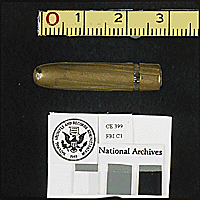 |
|
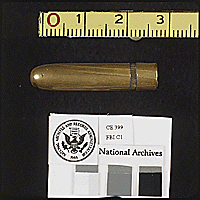 |
|
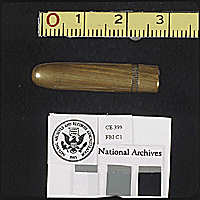 |
|
|
|
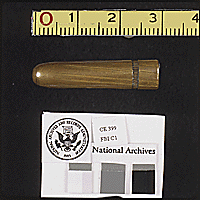 |
|
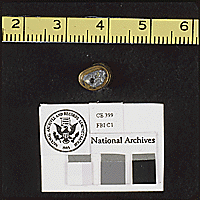 |
|
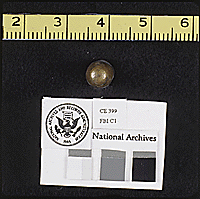 |
|
|
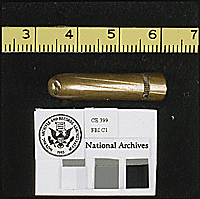 |
|
Dr. WECHT: Commission exhibit 399...a side view...shows the copper jacket to be completely intact, unscathed with no deformity, mutilation or markings... The small defect at the tip is where a piece of metal was properly taken by the FBI for spectographic analysis...
...the nose, the penetrating portion of the missile which is completely unmarked and without any scathing at all...
...the base of the bullet which is the only area of deformity, what I would refer to as some flattening with indentation of the metallic rim and focal extrusion of the inner lead core. That is the only deformity.
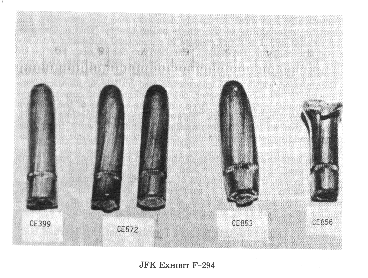
HSCA/JFK Exhibit F-294
Dr. WECHT: This exhibit, F-294, is a composite photo that I believe clearly, dramatically and most succinctly demonstrates the absurdity, the scientific untenability of the single bullet theory. This is Commission exhibit 399. I will not engage in semantical quibbling with my friend and collegue, Dr. Baden, whether you can be near pristine or fully pristine. It is a near pristine bullet, again, with the only deformity being demonstrated at the base... Mr. PURDY: Dr. Wecht, is it your opinion that no bullet could have caused all of the wounds to President Kennedy and Governor Connally or the Commission exhibit 399 could not have caused all of the wounds to both men?
Dr. WECHT: Based upon the findings in this case, it is my opinion that no bullet could have caused all these wounds, not only 399 but no other bullet that we know about or any fragment of any bullet that we know about in this case.
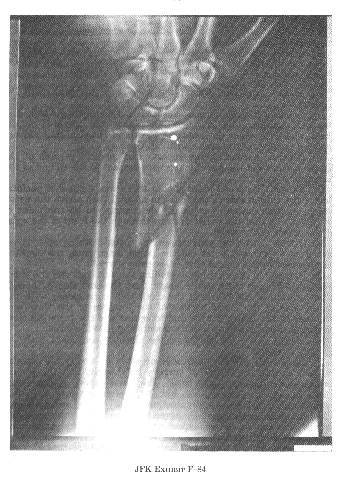
Dr. BADEN: [After asking for and receiving the above wrist X-ray of Governor Connally] The wrist was explored and operated on, and recovered from the wrist was some cloth fabric which matched the jacket of Connally. Thank you. And the largest of those metal fragments, I think there are three fragments that are visible from this distance, overlay the distal radius near the wrist - the largest of those three fragments was removed by the surgeons in the course of their operation and preserved, kept at the Archives and made available to the committee many years later. Mr. FITHIAN: The other fragments were not removed?Wait a moment...besides the fragments removed from the Governor's wrist - shown below in Commission Exhibit CE842...
Dr. BADEN: The other fragments were not removed and are still present as demonstrated on subsequent X-rays available to the committee when the Governor's arm was healing.
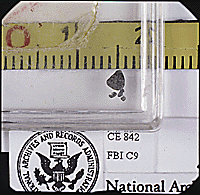
Where did they come from?
The Warren Commission ignored their own expert witnesses when they concluded that "All the evidence indicated that the bullet found on the Governor's stretcher could have caused all his wounds."
Photographs courtesy of FOIA and Special Access Records (NWCTF), National Archives at College Park, 8601 Adelphi Road, College Park, MD 20740-6001.
No comments:
Post a Comment